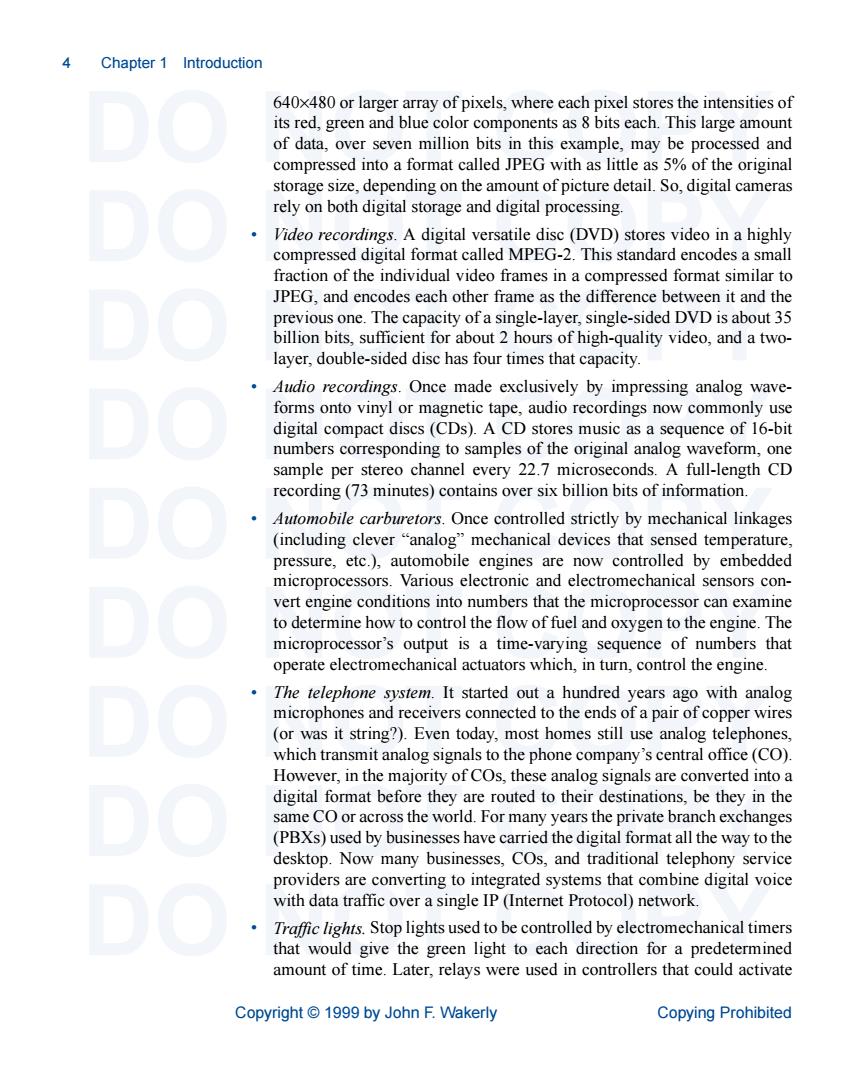正在加载图片...

4 Chapter 1 Introduction 640x480 or larger array of pixels,where each pixel stores the intensities of compressed into a format called JPEG with as little as 5%of the original storage size,depending on the amount of picture detail.So,digital cameras rely on both digital storage and digital processing. Video recordings.A digital versatile disc(DVD)stores video in a highly compressed digital format called MPEG-2.This standard encodes a small fraction of the individual video frames in a compressed format similar to JPEG,and encodes each other frame as the difference between it and the previous one.The capacity of a single-layer,single-sided DVD is about 35 billion bits,sufficient for about 2 hours of high-quality video,and a two- layer,double-sided disc has four times that capacity Audio recordings.Once made exclusively by impressing analog wave forms onto vinyl or magnetic tape,audio recordings now commonly use digital compact discs(CDs).A CD stores music as a sequence of 16-bit numbers corresponding to samples of the original analog waveform,one sample per stereo channel every 22.7 microseconds.A full-length CD recording(73 minutes)contains over six billion bits of information. Automobile carburetors.Once controlled strictly by mechanical linkages microprocessors.Various electronic and electromechanical sensors con- vert engine conditions into numbers that the microprocessor can examine to determine how to control the flow of fuel and oxygen to the engine.The microprocessor's output is a time-varying sequence of numbers that operate electromechanical actuators which,in turn,control the engine The telephone system.It started out a hundred years ago with analog microphones and receivers connected to the ends of a pair of copper wires (or was it string?).Even today,most homes still use analog telephones. which transmit analog signals to the phone company's central office(CO). However,in the majority of COs,these analog signals are converted into a digital format before they are routed to their destinations,be they in the same CO or across the world.For many years the private branch exchanges (PBXs)used by businesses have carried the digital format all the way to the desktop.Now many businesses,COs,and traditional telephony service providers are converting to integrated systems that combine digital voice with data traffic over a single IP(Internet Protocol)network. Traffic lights.Stop lights used to be controlled by electromechanical timers that would give the green light to each direction for a predetermined amount of time.Later,relays were used in controllers that could activate Copyright1999 by John F.Wakerly Copying Prohibited 4 Chapter 1 Introduction DO NOT COPY DO NOT COPY DO NOT COPY DO NOT COPY DO NOT COPY DO NOT COPY DO NOT COPY DO NOT COPY DO NOT COPY Copyright © 1999 by John F. Wakerly Copying Prohibited 640×480 or larger array of pixels, where each pixel stores the intensities of its red, green and blue color components as 8 bits each. This large amount of data, over seven million bits in this example, may be processed and compressed into a format called JPEG with as little as 5% of the original storage size, depending on the amount of picture detail. So, digital cameras rely on both digital storage and digital processing. • Video recordings. A digital versatile disc (DVD) stores video in a highly compressed digital format called MPEG-2. This standard encodes a small fraction of the individual video frames in a compressed format similar to JPEG, and encodes each other frame as the difference between it and the previous one. The capacity of a single-layer, single-sided DVD is about 35 billion bits, sufficient for about 2 hours of high-quality video, and a twolayer, double-sided disc has four times that capacity. • Audio recordings. Once made exclusively by impressing analog waveforms onto vinyl or magnetic tape, audio recordings now commonly use digital compact discs (CDs). A CD stores music as a sequence of 16-bit numbers corresponding to samples of the original analog waveform, one sample per stereo channel every 22.7 microseconds. A full-length CD recording (73 minutes) contains over six billion bits of information. • Automobile carburetors. Once controlled strictly by mechanical linkages (including clever “analog” mechanical devices that sensed temperature, pressure, etc.), automobile engines are now controlled by embedded microprocessors. Various electronic and electromechanical sensors convert engine conditions into numbers that the microprocessor can examine to determine how to control the flow of fuel and oxygen to the engine. The microprocessor’s output is a time-varying sequence of numbers that operate electromechanical actuators which, in turn, control the engine. • The telephone system. It started out a hundred years ago with analog microphones and receivers connected to the ends of a pair of copper wires (or was it string?). Even today, most homes still use analog telephones, which transmit analog signals to the phone company’s central office (CO). However, in the majority of COs, these analog signals are converted into a digital format before they are routed to their destinations, be they in the same CO or across the world. For many years the private branch exchanges (PBXs) used by businesses have carried the digital format all the way to the desktop. Now many businesses, COs, and traditional telephony service providers are converting to integrated systems that combine digital voice with data traffic over a single IP (Internet Protocol) network. • Traffic lights. Stop lights used to be controlled by electromechanical timers that would give the green light to each direction for a predetermined amount of time. Later, relays were used in controllers that could activate